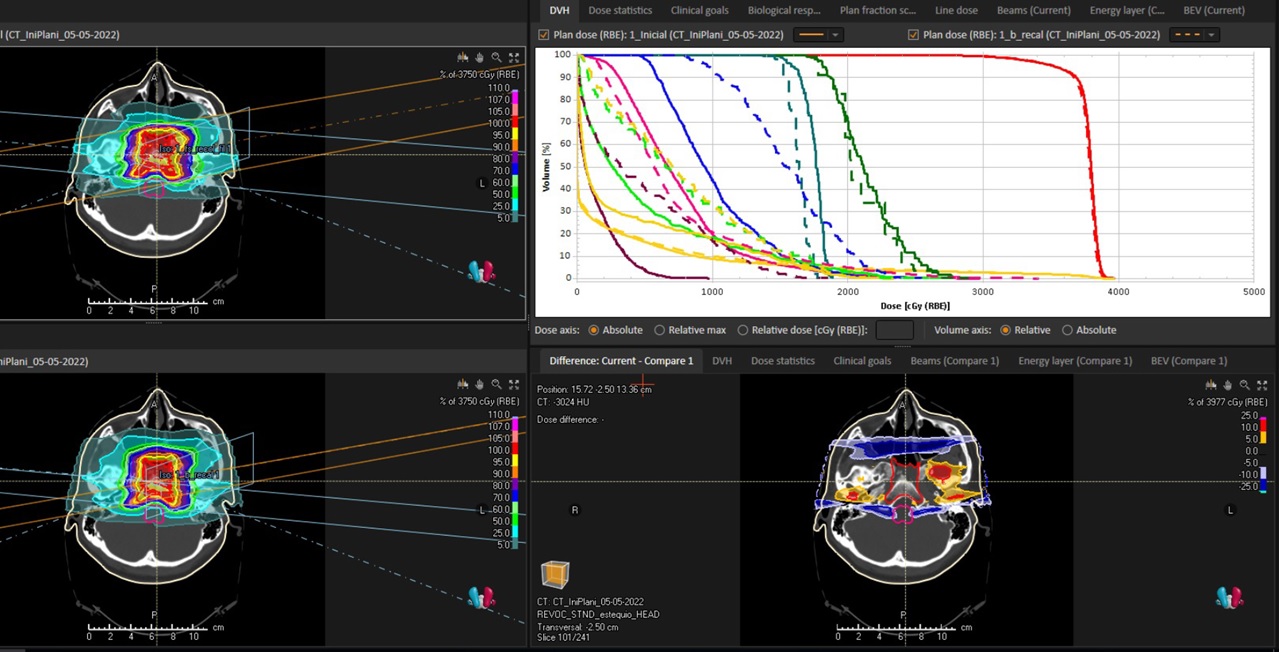Five-fraction protontherapy for skull base chordomas and chondrosarcomas: first experience
PO-1558
Abstract
Five-fraction protontherapy for skull base chordomas and chondrosarcomas: first experience
Authors: Morena Sallabanda1, Juan Antonio Vera2, Juan María Pérez2, Marta Montero1, Ana de Pablo1, Raúl Matute1, Juan Castro2, Fernando Cerrón2, Alejandro Mazal2, Raymond Miralbell1
1Centro de Protonterapia Quirónsalud, Radiation Oncology, Madrid, Spain; 2Centro de Protonterapia Quirónsalud, Medical Physics, Madrid, Spain
Show Affiliations
Hide Affiliations
Purpose or Objective
To describe acute toxicity and dosimetric parameters of the first five patients with chordomas or condrosarcomas of the skull base treated with five-fraction hypofractionated protontherapy.
Material and Methods
Five consecutive patients with biopsy proven diagnosis of chordoma or chondrosarcoma of the skull base were included in a prospective protocol of extremely hypofractionated protontherapy between June and September of 2022. The established inclusion criteria for this protocol were: Age > 18 yo., Karnofsky Performance Status (KPS) ≥ 70%, absence of metastatic disease, clinical target volume (CTV) up to 50 cc and CTV location relative to organs at risk as brainstem or optic pathway that allowed compliance with the necessary dose restrictions for hypofractionated treatments in 5 fractions, according to the international guidelines. Treatment was delivered with a Proteus®ONE IBA cyclotron using Pencil Beam Scanning (PBS) Intensity-Modulated Proton Therapy (IMPT). Patient setup was performed with CBCT imaging at isocenter and X-Ray obliques before each non coplanar beam, allowing a robust planning with 1 mm setup uncertainty and 3.5% range uncertainty. IMPT plans were obtained with RayStation (Raysearch) employing four beams. In two of the beams, apertures were used in order to reduce lateral penumbra and to optimize dose gradient.
Results
Five patients (four males and one female) with an age range between 29 and 79 yo., were included. Three patients with classic chordomas and two patients with grade I-II condrosarcomas were treated with a total dose of 37.5 Gy and 35 Gy, respectively, in 5 daily fractions. All the patients had received previous surgery obtaining subtotal resection. Baseline KPS after surgery was 90%. CTV range was 10-39 cc. All patients were treated with 4 lateral oblique non coplanar beams. Median CTV coverage was V95%=D95%. Dose constraints for the brainstem, optic pathway and temporal lobes were achieved. Clinical tolerance during treatment was excellent with grade I asthenia and headache in 3 patients and grade I nausea in one patient. Median clinical follow-up was 3 months (range 1-3 months). Two patients described persistent grade I asthenia, but the overall acute tolerance was remarkable.
Conclusion
Five-fraction hypofractionated protontherapy for the treatment of skull base chordomas and condrosarcomas is dosimetrically feasible and well tolerated with very low acute toxicity for selected patients. Protontherapy remains a limited resource and many patients must travel to access this technology. Consequently, reducing the time a patient is away from their home and support network can have significant financial and psychosocial implications. In addition, due to the low alfa/beta ratio of these malignances, there is a radiobiological advantage related with the use of extremely hypofractionated regimens. Longer follow-up is necessary to further validate treatment tolerance and local control.